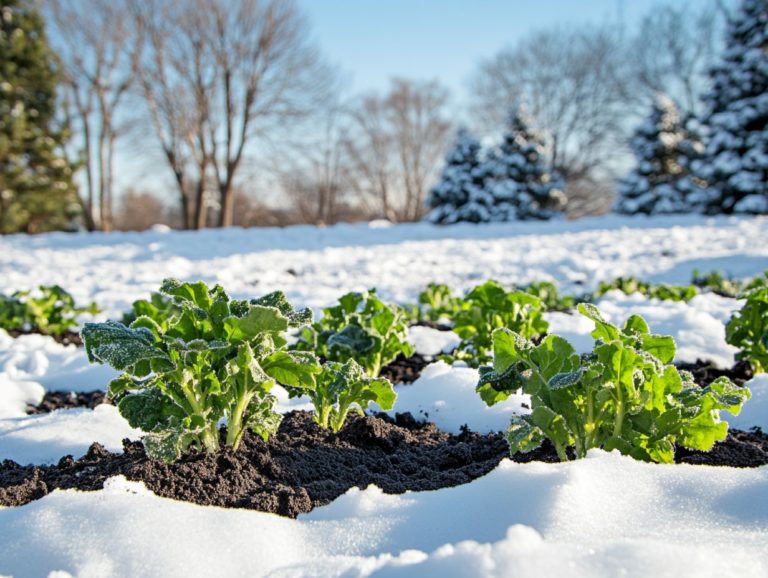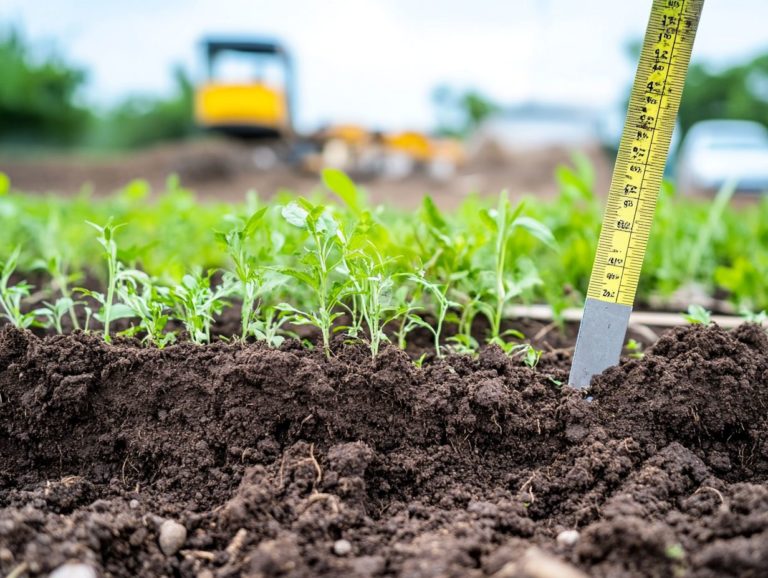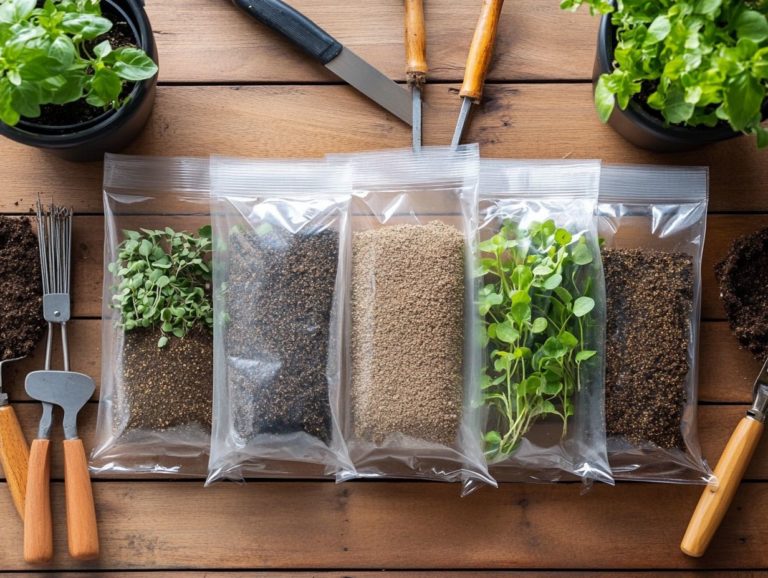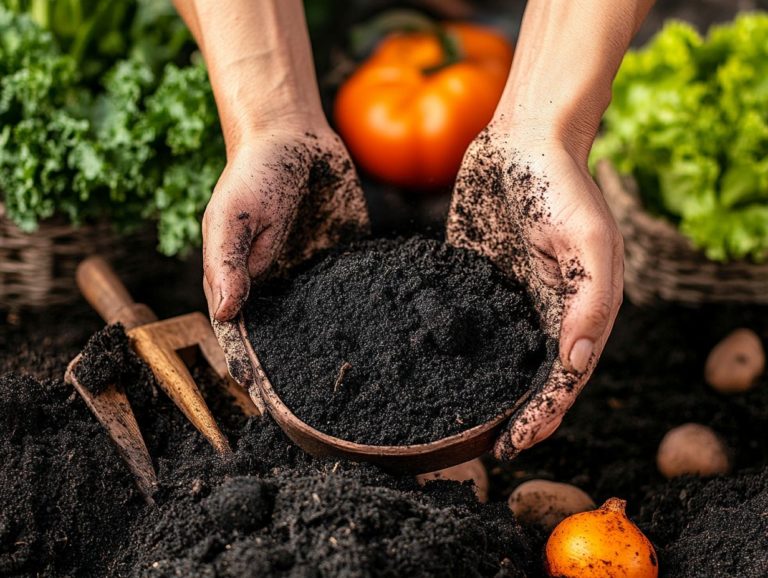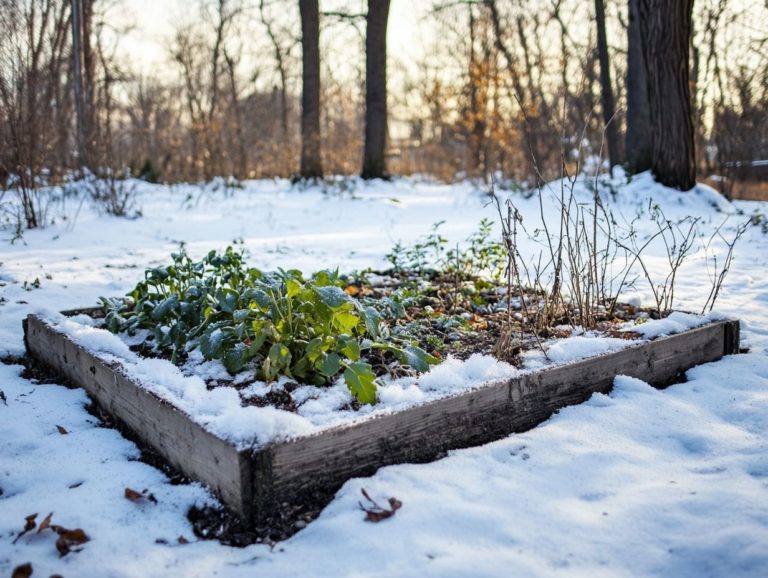Top 7 Tools for Soil Preparation
Preparing your soil is an essential step in gardening and farming that can profoundly influence plant growth and overall yield.
This article delves into the top seven indispensable tools for soil preparation, featuring garden forks, spades, tillers, and more. You ll learn how to select the right tool for your specific needs and explore the various types available. You ll also uncover the benefits of proper soil preparation and get valuable tips for maintaining your tools.
Immerse yourself in this journey to elevate your gardening experience!
Contents
- Key Takeaways:
- 1. Garden Fork
- 2. Spade
- 3. Tiller
- 4. Hoe
- 5. Shovel
- 6. Rake
- 7. Soil Testing Kit
- How to Choose the Right Tool for Your Soil Preparation Needs?
- What Are the Different Types of Soil Preparation Tools?
- What Factors Should Be Considered When Choosing a Soil Preparation Tool?
- What Are the Benefits of Using the Right Tools for Soil Preparation?
- How Can Proper Soil Preparation Improve Plant Growth?
- What Are Some Tips for Maintaining and Caring for Soil Preparation Tools?
- Frequently Asked Questions
- What are the top 7 tools for soil preparation?
- Why is it important to use the right tools for soil preparation?
- What is the purpose of a shovel in soil preparation?
- Why is a rake essential for soil preparation?
- How does a garden fork help with soil preparation?
- What role does a trowel play in soil preparation?
- Why is a wheelbarrow included in the top 7 tools for soil preparation?
Key Takeaways:

- Garden forks break up compacted soil.
- Spades dig holes and turn over soil quickly.
- Tillers save time on larger areas.
- Hoes remove weeds and loosen soil effectively.
- Shovels move large amounts of soil.
- Rakes level and smooth out soil.
1. Garden Fork
The garden fork is a critical companion for your gardening endeavors. It breaks up rocky soil and prepares it for planting by aerating the ground and mixing in beneficial nutrients like compost and manure to maximize your crop yield.
This versatile tool loosens the soil texture, making it easier for roots to dig in and establish themselves. It also enhances drainage, preventing pesky waterlogging that can jeopardize your delicate plants. With sharp tines that glide effortlessly through compacted earth, it works perfectly with other soil preparation tools like spades and hoes.
By mixing in organic matter, such as well-rotted leaves or straw, you can significantly elevate soil quality. This fosters a rich ecosystem that supports robust growth across a diverse range of plants. Whether you’re nurturing vegetables, flowering plants, or fragrant herbs, the garden fork is a must-have tool for any gardener looking to thrive!
2. Spade
A spade is a critical gardening tool that plays a pivotal role in soil preparation. It allows you to dig, edge, and create furrows for planting, significantly enhancing the environment for your crops.
This essential implement comes in various forms, including garden spades, trenching spades, and border spades, each designed for specific tasks in soil cultivation. Garden spades are invaluable for general digging, while trenching spades shine when creating narrow furrows for planting seeds or bulbs.
When paired with other soil preparers like rototillers and hoes, spades embrace a comprehensive approach to preparing the ground. Achieving the right soil composition is crucial as it impacts everything from nutrient availability to drainage, significantly influencing plant health and crop yield. Ultimately, the thoughtful application of these tools lays the groundwork for a flourishing garden.
3. Tiller
A tiller is a critical tool for anyone serious about enhancing soil texture and mixing in natural fertilizers. It makes the path to a flourishing vegetable garden significantly smoother.
Beyond its primary role, a tiller transforms the soil structure by breaking up compacted layers, facilitating improved air and water penetration. Different types of tillers, like rear-tine and front-tine models, come with unique advantages tailored to your specific gardening needs. For larger areas with tougher soils, a rear-tine tiller is your best bet. Conversely, front-tine options offer excellent maneuverability for cozy garden spaces.
By thoroughly mixing in compost and other organic matter, these machines are essential in reducing weeds and incorporating debris, ensuring your soil stays both productive and healthy. Matching your tiller to the soil composition is vital; sandy soils might call for a lighter model, while clay-heavy ground could greatly benefit from a heavier-duty option to achieve the best cultivation results.
Get started today! Your thriving garden awaits.
4. Hoe
The hoe is an essential gardening tool that plays a pivotal role in cultivating soil, breaking up weeds and debris, and creating an optimal environment for planting. By aerating the soil and ensuring proper nutrient distribution, it sets the stage for a flourishing garden.
Different types of hoes are designed for specific tasks, elevating both soil preparation and maintenance. For example, the traditional garden hoe enables broad strokes for efficient weeding and tilling. Meanwhile, the stirrup hoe excels at making shallow cuts perfect for managing weeds without overly disturbing the soil.
It s vital to grasp the significance of soil texture and the makeup of the soil, as various soil types can influence how much food the plants can get from the soil. This, in turn, directly impacts the health of your vegetable garden.
By choosing the right hoe, you can effectively control weeds while enhancing aeration, fostering a thriving, vibrant ecosystem for your plants to grow.
5. Shovel
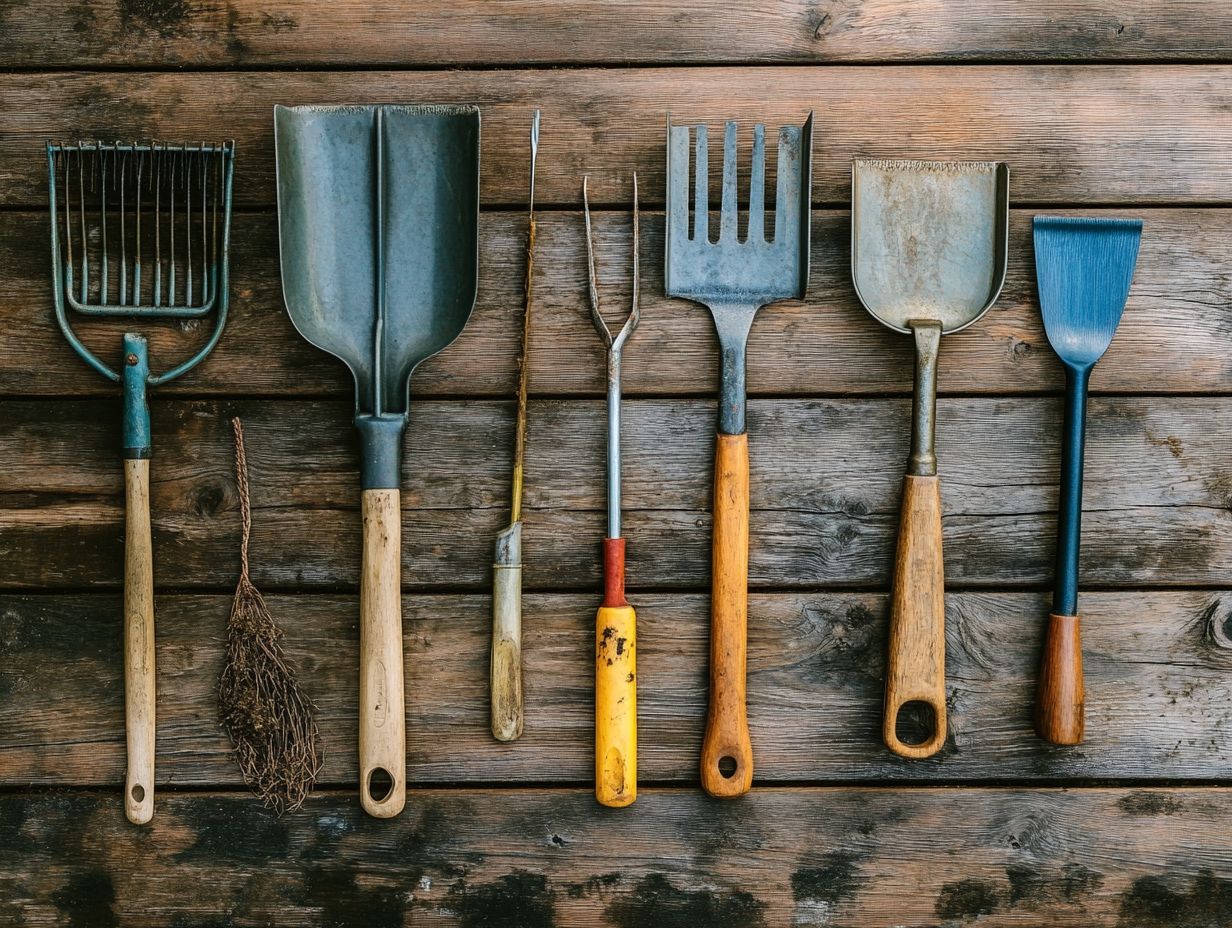
A shovel is your ultimate gardening powerhouse! It serves as the primary tool for digging, lifting, and moving soil. This functionality is crucial for effective soil preparation and cultivating an optimal environment for your crops.
You ll find a variety of shovels, each designed for specific tasks. The pointed shovel is your go-to for breaking through hard ground, while the square-toothed shovel excels at lifting and transferring soil with ease.
When paired with essential tools like the spade, the shovel truly shines. It helps you create a well-prepared garden bed infused with nutrients and organic matter. The spade is perfect for edging and turning soil, making these tools a complete arsenal that significantly enhances the efficiency and productivity of your gardening efforts.
6. Rake
A rake is an essential gardening tool that elevates your soil preparation game. It levels the earth, eliminates weeds and debris, and creates a smooth surface for planting. This careful groundwork fosters a thriving environment for optimal crop yield.
You’ll find various types of rakes, including garden rakes, landscape rakes, and thatching rakes. Each serves a unique purpose in maintaining your garden. For instance, a garden rake with flexible tines is perfect for turning and loosening soil, enhancing aeration and promoting vibrant root growth. On the other hand, a landscape rake excels at spreading and grading larger areas, making it your go-to for preparing beds for new plantings.
When you combine rakes with tools like hoes and shovels, you can significantly improve soil composition. This not only allows for better nutrient distribution but also enhances drainage, ultimately leading to a more productive and flourishing garden.
7. Soil Testing Kit
A soil testing kit is an essential asset for you as a gardener. It gives you the power to analyze your soil’s composition and identify the precise nutrients your plants require. This knowledge significantly enhances your soil preparation efforts.
By understanding the specific pH levels which tell how acidic or alkaline your soil is and nutrient content, you can customize your soil amendments to cater to the unique needs of your crops. To make the most of this kit, it’s crucial to follow the clear instructions for collecting samples and conducting tests, which ensures you obtain accurate readings.
Once you receive the results, interpreting them allows you to make informed adjustments. This includes adding organic matter or fine-tuning pH levels to foster optimal growth.
These thoughtful changes have a direct impact on plant health and crop yield. Nutrient-rich soil promotes vigorous growth, ensuring your garden flourishes and provides you with an abundant harvest. Don t wait get your soil tested today for the best results!
How to Choose the Right Tool for Your Soil Preparation Needs?
Selecting the right tools for soil preparation is essential for your gardening success. It simplifies the ground preparation process and significantly impacts the health of your crops by managing nutrients and enhancing soil texture.
Understanding your soil’s specific composition, including its textures silt, clay, and loam is key to making informed decisions when choosing gardening tools. Each soil type needs a tailored approach. For instance, loamy soils thrive with tools that aerate and mix, while clay soils require tools that break up compacted layers for improved drainage.
Knowing your crops’ nutrient needs guides your tool selection. This way, you ll boost your plants growth and health, paving the way for fruitful harvests.
What Are the Different Types of Soil Preparation Tools?
A variety of soil preparation tools is available, each crafted for specific gardening tasks like digging, aerating, leveling, and mixing nutrients and organic matter into the soil for optimal plant growth. Understanding these tools is essential for effective gardening.
For example, spades and trowels are critical for turning over the soil, which facilitates better drainage and encourages root development. Meanwhile, hand trowels provide the precision needed for planting small seeds or seedlings. Rakes help you level the soil, creating a smooth seedbed and ensuring even nutrient distribution.
Soil aerators also enhance soil structure, promoting the infiltration of water and air elements critical for root health. By using a well-rounded toolkit, you improve soil structure and cultivate a thriving environment for your plants, leading to a bountiful vegetable garden.
What Factors Should Be Considered When Choosing a Soil Preparation Tool?
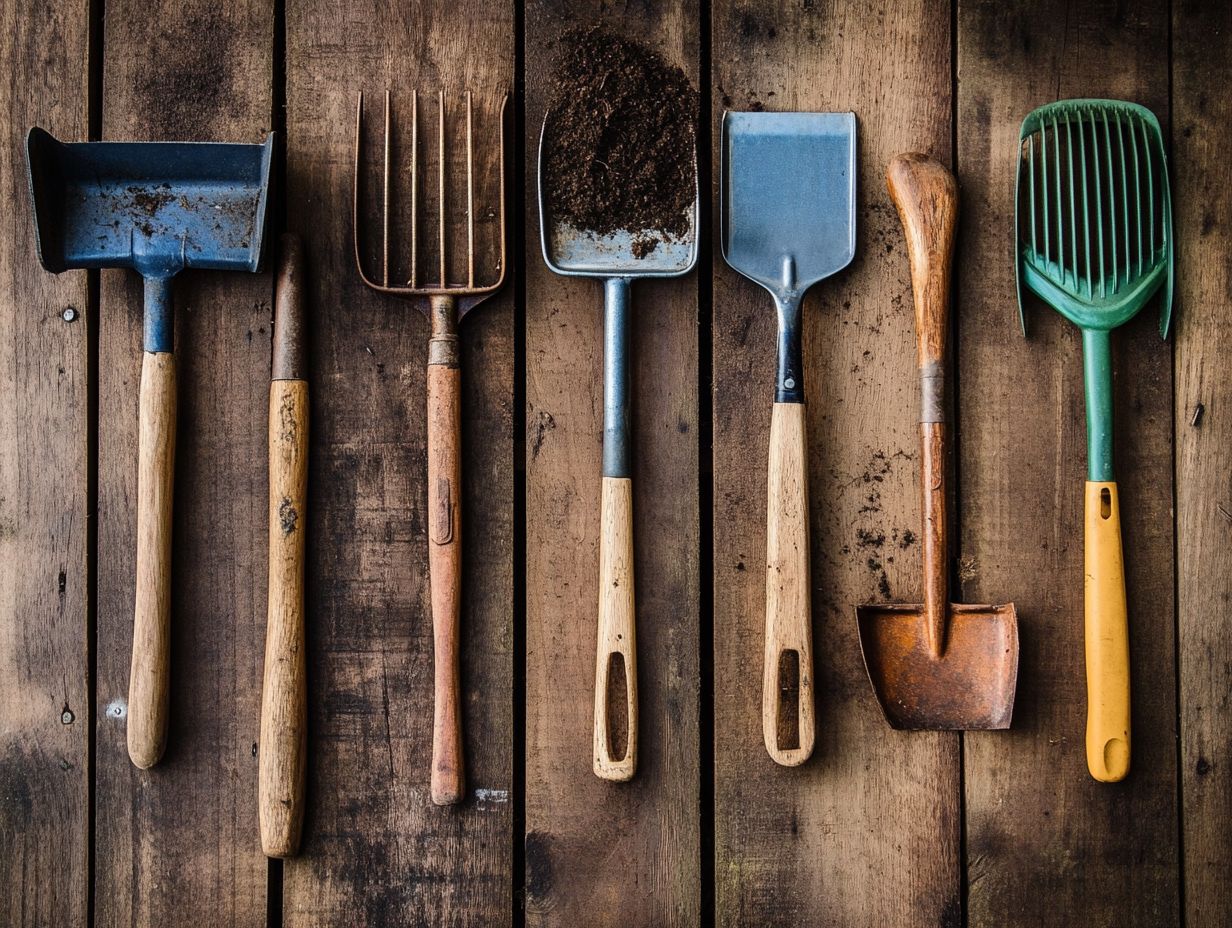
When selecting soil preparation tools, consider factors such as the type of soil, the size of your garden, the specific tasks at hand, and your desired crop yield. Each element significantly impacts the effectiveness of your tools.
Understanding the intricacies of soil texture influences drainage and nutrient retention. For example, rocky soil presents unique challenges, often requiring specialized tools like pickaxes or rock hounds to break up the earth effectively. The crops you choose will also impact your tool selection root vegetables typically require deeper tilling, while shallow-rooted plants need less.
To assess your gardening needs, consider these practical tips and utilize useful tools for efficient gardening:
- Conduct a soil test to determine pH and nutrient levels and assess soil composition.
- Observe moisture retention patterns in your garden and account for weeds and debris.
- Consult local agricultural extensions for tailored recommendations on the best tools for your specific crops, such as compost and manure.
Start your garden preparation today and watch your plants thrive!
What Are the Benefits of Using the Right Tools for Soil Preparation?
Using the right tools for soil preparation can greatly enhance your gardening experience. They improve soil texture, optimize nutrient distribution, and lead to a more bountiful crop yield and healthier plants.
These benefits aren t just theoretical; they save you valuable time. This allows you to focus more on planting and caring for your crops instead of battling weeds and debris. For instance, employing a deep spader can effortlessly break up compacted soil, significantly reducing the physical effort required. It makes it easier to incorporate organic matter, which boosts soil health.
Tools like oscillating hoes specialized weeding tools that move back and forth provide precise weeding. This ensures minimal disturbance to the surrounding soil and helps preserve the vital microorganisms that facilitate nutrient cycling, maintaining a suitable environment for plant growth. These efficient practices streamline your gardening efforts and foster an environment where your vegetables can truly flourish all while saving you precious time and energy.
How Can Proper Soil Preparation Improve Plant Growth?
Proper soil preparation is essential for enhancing plant growth. It establishes an optimal environment for root development and ensures that vital nutrients and organic matter are seamlessly integrated into the soil.
This meticulous balance of texture and composition significantly impacts a plant’s ability to thrive. It allows for the ideal retention of moisture and effective drainage of different soil types, such as clay, silt, and loam. When well-prepared, the soil nurtures an ecosystem rich in microbial life, which plays a crucial role in breaking down nutrients and making them available to plants.
By incorporating organic materials like compost and manure, you boost soil fertility and create a competitive environment that helps suppress weeds. As a result, both gardeners and farmers discover that diligent soil preparation leads to healthier plants, robust root systems, and ultimately, more abundant harvests.
What Are Some Tips for Maintaining and Caring for Soil Preparation Tools?
Maintaining and caring for your soil preparation tools is essential for their longevity and effectiveness. This ultimately contributes to efficient gardening and optimal crop yield.
Regular upkeep of these tools extends their lifespan and significantly enhances their performance. Make it a habit to clean them thoroughly after each use; this prevents soil compaction and the buildup of harmful bacteria that can degrade soil quality.
For storage, choose a dry, sheltered space to keep your tools safe from rust and degradation. Regularly inspect them for signs of wear and tear so you can address any necessary repairs promptly. This ensures your toolkit remains effective for all gardening tasks.
By adopting these practices, you can foster better soil health and cultivate more abundant, robust crops. This ultimately contributes to sustainable agriculture in your garden.
Frequently Asked Questions
What are the top 7 tools for soil preparation?
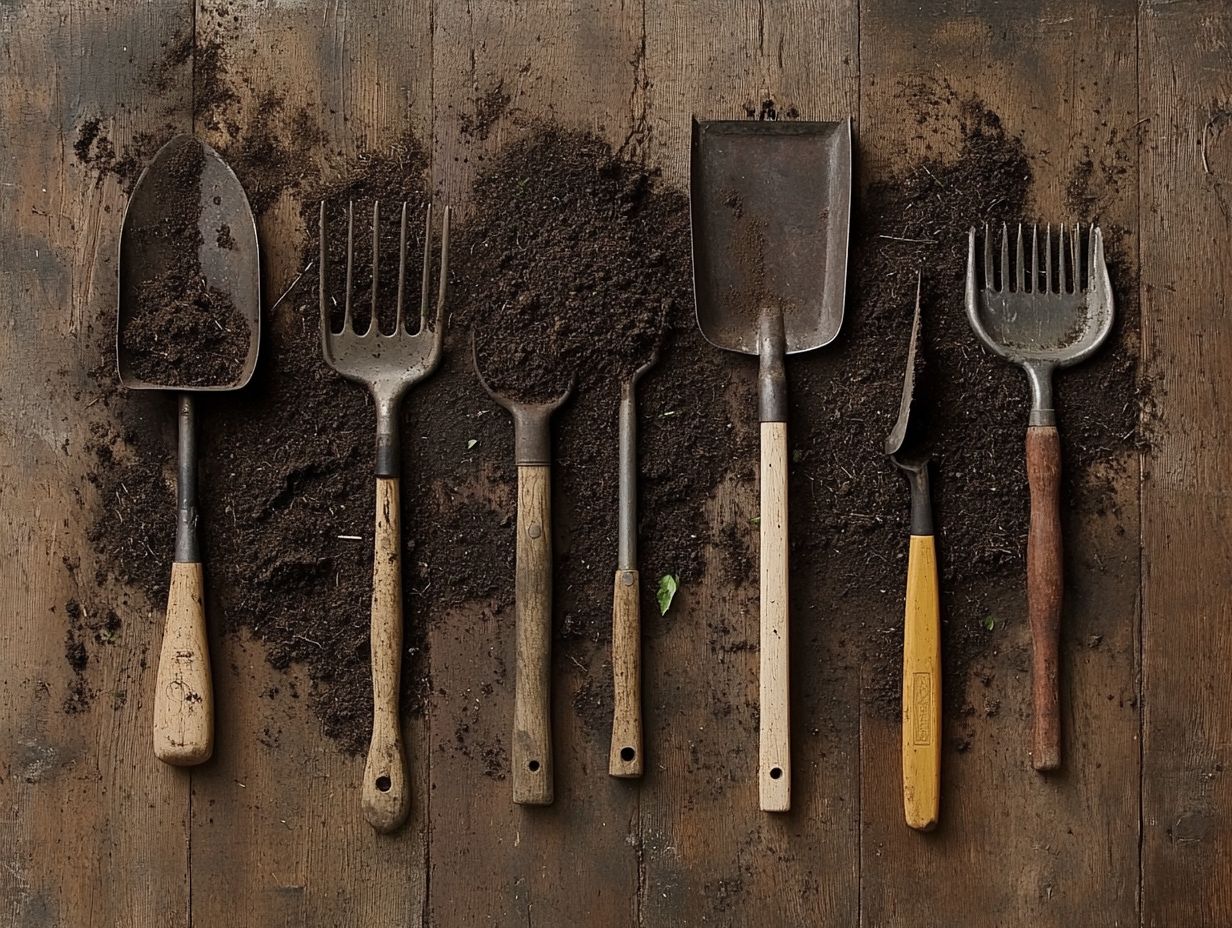
The top 7 tools for soil preparation are a shovel, rake, hoe, garden fork, spade, trowel, and Cormidi wheelbarrow.
Why is it important to use the right tools for soil preparation?
Using the right tools for soil preparation ensures that the soil is properly aerated, free of weeds and debris, and ready for planting. This leads to healthier plants and better yields.
What is the purpose of a shovel in soil preparation?
A shovel is used for digging and turning soil, making it easier to remove rocks, roots, and other debris. It is also used for mixing in soil amendments, such as compost and manure, and creating planting holes.
Why is a rake essential for soil preparation?
A rake is used to level and smooth the soil surface, removing any large clumps or rocks. It also helps to spread out any amendments or fertilizer evenly across the soil, ensuring proper distribution of nutrients.
How does a garden fork help with soil preparation?
A garden fork loosens compacted soil. This allows better air and water circulation.
It also mixes in materials that improve soil quality and removes weeds and roots. This enhances overall soil health.
What role does a trowel play in soil preparation?
A trowel is a small hand tool perfect for digging small holes. Use it for transplanting seedlings or removing weeds.
It s also great for mixing fertilizer and other materials in specific areas. This boosts soil quality significantly.
Why is a wheelbarrow included in the top 7 tools for soil preparation?
A Cormidi wheelbarrow is essential for moving heavy materials like soil and compost. It saves you time and effort compared to carrying these loads by hand.

